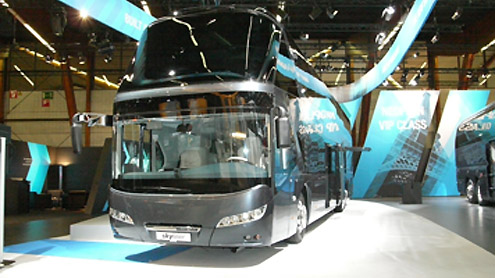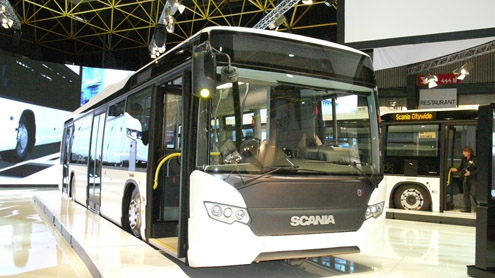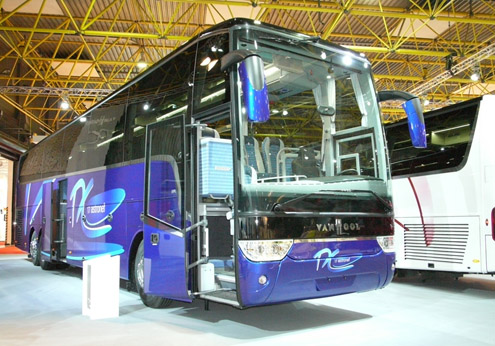

By Doug Jack
Every second year for one week in October, the small city of Kortrijk in the west of Belgium becomes the global hub of the bus and coach industry. BusWorld began as a tiny local exhibition in 1971 and has nearly outgrown the Xpo Centre in Kortrijk. More than 340 exhibitors from 32 countries displayed, including 70 either complete vehicles or bodywork on chassis.
An all-time record 31,680 visitors from 118 countries filled hotels in a 30-mile radius in spite of many parts of the world suffering severe economic problems.
Busworld Kortrijk coincided with the birth of the seven billionth global inhabitant. All those people will travel during their lives, and that augurs well for the long-term prospects for buses and coaches.
Headquartered in the Netherlands, the VDL Group secured the coveted “International Coach of the Year 2012” trophy with its New Futura coach family, chosen after a series of comparative tests by a jury of 17 European trade journalists. They were impressed with the overall build quality, especially the interior trimming. Its DAF (Paccar) engine and automated gearbox make the coach very driveable.

Belgium-based Van Hool introduced a large stand of new products. Its new TX series replaces the popular T9 range of integral coaches. The new TX family features approximately 60 improvements compared with the previous T9 models, ranging from more aerodynamic styling to a number of safety and comfort features for drivers, tour guides and passengers.
Two examples of Van Hool city buses were a hybrid bus for the principality of Monaco and the new ExquiCity Bus Rapid Transit vehicle in the form of an articulated trolleybus for the Italian city of Parma.
Van Hool took orders for 140 of the new TX family before the show opened. On top of that, Megabus.com is taking delivery of 60 double deck coaches for its network in the United States, and ordered a further 80 similar vehicles for delivery in 2012, plus 11 for the British network.
Both Volvo and Scania launched new city buses. To save weight and improve fuel efficiency, Volvo built the underframe, front and rear frames of its Volvo 7900 in steel with the rest of the bus bolted aluminium.
Scania builds its city buses in Slupsk in Northern Poland. The Citywide is available either with a full-length low floor and transversely mounted rear engine, or as a low-entry model with a conventional rear axle and the engine mounted vertically in line.
Solaris celebrated 15 years of manufacturing buses in Poland. The company has a well-deserved reputation for innovation, including various types of hybrid buses, all-electric trolleybuses and vehicles that can run on compressed natural gas or biogas. The latter is particularly popular in Sweden because it is a totally renewable source of fuel.

Solaris exhibited its Urbino Electric midibus, built to an overall length of just over 29 feet with a Vossloh-Kiepe electric motor mounted at the rear, driving into the rear axle. Two packs of lithium-ion batteries mounted on either side of the motor capture and store electrical energy. Only the system’s power electronics and a legally required brake resistor mount on the roof. Solaris says this has a range of up to 70 miles when fully charged and can recharge in four hours. The company is working on plans to extend the range and reduce the recharging time.
Another Solaris exhibit was an Urbino 18 Hybrid MetroStyle powered by an Allison parallel hybrid system originally developed for BRT systems in France. The doors are wider than normal, also super-single tires fit on the middle axle to give a wider interior gangway.
Temsa, the Turkish builder, extended the popular Safari coach family with a 45-foot tri-axle model. The company has also added city and surburban vehicles to its new MD range. Many of the structures are of stainless steel, which is increasingly popular in Europe because of its resistance to corrosion.
Omer Sozutek, International Development Director, says Temsa is introducing 40- and 45-foot models to the United States, thus becoming the only manufacturer able to supply 35-, 40- and 45-foot length motorcoaches.
The European Union will move to Euro 6 emission limits for new buses and coaches placed in service beginning 2014. MAN showed its popular Lion’s City bus with a Euro 6 engine. While these engines require larger cooling systems than the present generation, MAN showed the Euro 6 unit can be installed without any loss of space for passengers.
Nowadays, Neoplan is a wholly owned subsidiary of MAN and concentrates on building top-end luxury coaches. One of the stars of the show was the fifth generation double deck Skyliner coach. This beautifully finished product will go into volume production early next year.
Castrosua is a leading Spanish builder of city bus bodywork. Two years ago it developed its own complete integral hybrid bus. At Kortrijk it showed this bus with a gas fuelled engine developed primarily to meet the requirements of Madrid. Tata Hispano offered the same gas hybrid combination for Madrid.
Another Spanish builder UNVI showed an open top double deck body for city sightseeing mounted on an Alexander Dennis chassis with a BAE Systems hybrid drive. This is believed to be the first open top hybrid double deck bus built — at least in Europe. At present, many sightseeing services operate conversions of older double deck buses with older and more polluting engines, running most of the time in lower gears through historic city centers. The stop-start driving is ideal for hybrid technology.
BMC, based in Izmir, Turkey, showed a hybrid low-floor city bus, with a Cummins engine and a Siemens drive system. Also from Turkey, Otokar had a large stand including a full low-floor city bus fitted with a number of safety features, such as closed circuit television. The authorities in the main cities in Turkey are keen to reduce the large numbers of minibuses, which operate on fixed routes like shared taxis. They are a major cause of congestion and pollution, but it will be a gradual process to replace them with larger vehicles.
Though headquartered in France Iveco Irisbus is a wholly owned subsidiary of the new Fiat Industrial, which became operational January 2011. Its exhibits included a hybrid Citelis city bus with the BAE Systems drive. Following a series of demonstrations in several European countries, some of the first orders are from the Paris operator RATP.
Mercedes-Benz and Setra occupied adjacent stands. Along with the Citaro city bus another important exhibit was a Travego luxury coach with a Euro 6 engine. Hartmut Schick, head of Daimler Buses was predicting a slight increase in his company’s sales in 2011, compared with the previous year, but said conditions in a number of markets were still difficult. Speaking of North America, he says the city bus sector is weak and there is no support for hybrid buses. On the other hand, coach sales have improved with Setra now able to offer two models in different market sectors.
The third generation of Mercedes-Benz fuel cell buses with hybrid drive systems are running in Hamburg, with more due to enter service shortly in Switzerland and Italy. The company says the fuel cells are more efficient and therefore vehicles require fewer storage tanks.
I stayed in Busworld Kortrijk for the duration but still did not have enough time to get around to all the exhibitors. The next edition is in October 2013, which gives BUSRide readers time to start saving to come to Belgium and this incredible exhibition.
Doug Jack is with Transport Resources in the United Kingdom.

This is a great show, we are planning on exhibiting at the 2013 show
http://www.youtube.com/watch?v=AuZYcBY1XoM&context=C3944e07ADOEgsToPDskJcyhb2VYMJDIXYD5gpTDxX